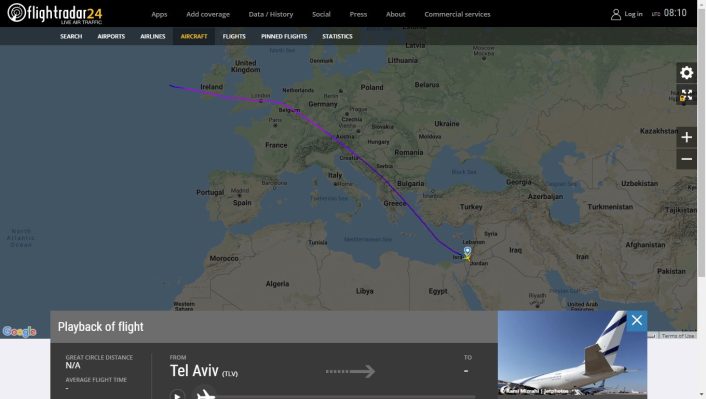Everything You Need To Know About The Supersonic Intercept And Sonic Boom That Rocked London At 04:16AM.
On Dec. 1, 2019, at approx 0400z two Royal Air Force Typhoons on QRA (Quick Reaction Alert) at RAF Coningsby were launched to respond to an aircraft experiencing temporary ComLoss with the ATC (Air Traffic Control).
Using the radio callsigns “5EA26” and “5EA27” the two aircraft were vectored to intercept N725SH, an ex El Al B767 4X-EAN, on its way to the U.S.

The two fighters accelerated to supersonic speed to reach the B767 that failed to respond to the ATC calls and the loud bang generated by the Typhoons could be clearly heard in London metropolitan area. CCTVs recorded the moment the two jets “broke” the sound barrier:
Heard nr Cambridge #sonicboom pic.twitter.com/7jIMg9IVCa
— Astrolad (@Wolfandskitty) December 1, 2019
As per SOP (Standard Operating Procedure) in the UK, the Typhoons were supported by a Voyager tanker (ZZ334) launched from RAF Brize Norton as TTN701.
‘Explosions’ heard across southern England. Sonic booms – Typhoons launched from RAF Coningsby go supersonic.
Voyager tanker out from RAF Brize Norton on a NATO Air Policing squawk. 👇
🇬🇧 Royal Air Force
Voyager ZZ334 TTN701 pic.twitter.com/dlp3ChdAzY
— CivMilAir ✈ (@CivMilAir) December 1, 2019
— Manu Gómez (@GDarkconrad) December 1, 2019
After radio comms were re-established the two Typhoons were cleared to return to RAF Coningsby and end their Sunday early morning mission.
On station in #AARA8 after this morning’s QRA shout… currently tanking with one of the QRA fighters (5EA27) comms on 264.350…https://t.co/UVbXxwmIhw pic.twitter.com/rSwuIJaxJx
— SR Airband & Aviation 📡✈🌍 (@Andy007_SR_A) December 1, 2019
The following video shows how RAF Typhoons respond to this kind of incidents.
COMLOSS events are more frequent than one might believe: according to NATO, loss of communications of civilian airliners with civilian air traffic controllers is the main reason for Alliance to launch alert fighter aircraft.
In 2018, Allied Air Command via the Combined Air Operation Centres (CAOCs) received more than 900 reports from the Nations about incidents where radio communications between a civilian airliner and civilian air traffic controllers had been lost. In almost one in ten of these incidents, Allied fighter aircraft on QRA are launched under NATO Air Policing procedures to fly up to the COMLOSS aircraft to verify the situation and visually provide instructions to the pilot to re-establish radio communications with the responsible ATC agency: indeed, since Sept. 11, 2001, COMLOSS has become a very serious security problem since controllers are unable to distinguish between simple communication failures and potentially dangerous reasons. On average NATO launches their fighters six times a month to respond to reported COMLOSS events. But what is quite striking is the fact that more 75 percent of the COMLOSS incidents is caused by human errors, just 15 percent is caused by technical reasons and 10 percent remain unknown. While launching QRA aircraft in response to such events is a training opportunity for both the aircrews and the air defense controllers, this activity may be a burden on the budget allocated to the military. For this reason, NATO and EUROCONTROL have created a joint task force for COMLOSS whose aim is to implement measures to reduce the human error by means of a campaign with airlines and air traffic controllers to highlight best practices and procedures and to create awareness among these communities.
I’ve often reported about COMLOSS events, especially those in Italy, where the rate of occurrences has been concerning in certain periods. Here are just a few examples:
Another day, another civil plane that gets intercepted by the Italian Air Force QRA after a loss of radio communication with the ATC. This rate of alert scrambles caused by civil traffic is unbelievable.
For the records: this time it was a Japan Air Commuter ATR72-600. pic.twitter.com/0rcnXdtR9r
— David Cenciotti (@cencio4) May 30, 2019
Nice shot of a Laudamotion A320 taken earlier today from an @ItalianAirForce Eurofighter Typhoon that was scrambled to intercept it because of a temporary loss of comms with the ATC agencies….I’m no longer logging all the QRA launches caused by loss of radio comms. pic.twitter.com/LIvFzhlNqz
— David Cenciotti (@cencio4) June 14, 2019
M .78 at FL410 intercepting a French C650 in temporary radio failure. This kind of photo is becoming a trademark of ItAF Eurofighter Typhoon pilots in QRA service at their 8th scramble for civvie that lost radio contact since the beginning of July. pic.twitter.com/XgTkEEm4Ul
— David Cenciotti (@cencio4) August 9, 2018
Dealing with sonic booms generated by interceptors on QRA they are nothing special: fighters need to intercept the civilian aircraft experiencing a loss of communication in the shortest time possible and to reach their “target” they can be cleared to perform a supersonic intercept “breaking” the sound barrier in the process. Supersonic intercepts are routine, when needed, all around the world. However, depending on the time of the day, period, region, etc, they can send the local media into a frenzy, especially after emergency agencies telephone switch boards start receiving reports of a large bang or “explosion”. However, as I commented in a past article about an Italian Air Force supersonic scramble:
Nothing special then, just “the sound of freedom”…









